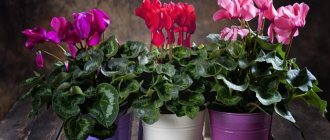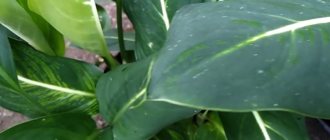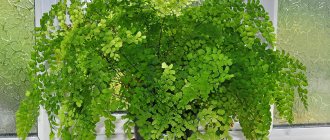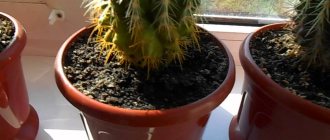The aspidistra plant is a perennial native to the tropical forests of East Asia. This plant is also called the “snake indicator”, this name is due to the fact that snakes often settle in it. When they crawl through the bushes, they touch the foliage. In this regard, in the aspidistra’s homeland, the rustling of its leaves is a sign that a poisonous predator is very close. This plant differs from others in its dense root system, complete absence of stems, and bright green long leaf blades that have a smooth surface. The flower is also characterized by slow growth and very rare flowering. The bush can bloom only in the summer and for only one day. This plant is hardy, it grows and develops well in places with a polluted atmosphere. It also tolerates lack of light well, as well as low indoor temperatures.
Description and origin
Aspidistra is a perennial herbaceous plant from the Asparagus genus. In the wild, the aspidistra plant grows in the subtropical forests of East Asia, in particular in Southern China, Japan and Taiwan. For home cultivation, only one type of plant is used - Aspidistra elatior Variegata or Aspidistra high.
The description of the flower is quite simple: the plant has no stem, the leaves grow on long petioles immediately from powerful tap-shaped roots. The leaves themselves are oval, dense, glossy, rich dark green. The plant reaches a height of 50-70 cm.
The flowering of this plant is an extremely rare occurrence. Aspidistra flowers appear in the summer and last only one day. Small, dirty purple flowers appear close to the ground and often go unnoticed due to the large leaves.
Where to put it.
One of the main maintenance conditions is light and temperature conditions, which must be taken into account when growing aspidistra.
— Lighting . Tolerates shade well. It can also grow on the northwest and northeast and north sides of your home. At a short distance from the window, aspidistra will also not be bad to grow. It will grow best in partial shade, but can tolerate very dark places in your room. Bright sun or lighting is contraindicated for this plant.
— Winter temperatures should not drop below 5 degrees and not exceed 20. The golden mean is 10 degrees. Thus, the summer temperature in the room can be tolerated well. In winter, you need to move the plant to cooler places. But even in winter, aspidistra tolerates room temperatures quite well.
- Humidity . This plant does not need spraying. It is better to wipe it with a damp cloth. This will moisten the leaves and remove excess dust. However, aspidistra tolerates spraying well. Small quantity is acceptable. The water should be warm and settled.
Care
Caring for aspidistra at home does not require any special skills. The main thing is to maintain conditions close to natural for the plant.
How to water
For irrigation, use water at room temperature; it is better to let it sit for several days.
- Watering. It needs to be watered evenly. Try not to overfill. Controlling the dryness of the earthen clod. As soon as the soil dries out, you can water it. In other words, you need to let the soil dry out. Allowing the soil to dry out is a serious mistake in care.
- Feeding. We add fertilizers during the period of active growth - from spring to autumn. It is better to do this once a month and use liquid mineral organic fertilizers. If you have a form with variegated leaves, you need to exclude any feeding at all. If you feed aspidistra with variegated leaves, over time they will become normal - green. It’s just that this view can be placed closer to a window or light source.
Temperature
Aspidistra prefers low temperatures of about 20°C in summer and 15-18°C in winter. The plant adapts much better to cold than to heat: at 10°C its vegetation phase actively begins, and at 25-30° the leaves begin to yellow and die.
Lighting
Aspidistra elatior naturally grows in the lower layer of subtropical forest, so it is perfectly adapted to partial shade. However, it cannot do without sunlight at all - the leaves begin to turn pale and the plant slowly dies.
It is best to place the flower pot on a western windowsill or curtain the window so that diffused light falls on the leaves.
Watering
The plant is not at all picky when it comes to watering. It is best to wet the earthen ball well 1-3 times a week so that it is moist, but not too wet. A single overfill or underfill will have absolutely no effect on the aspidistra.
The plant practically does not require spraying, except on hot days. It is much more useful to wipe the leaves from dust with a damp cloth.
Despite the ease of caring for aspidistra indoors, it is better to pre-prepare the water for irrigation:
- The ideal water for watering flowers is rainwater;
- Water for flowers should be at room temperature - too cold or hot water can damage the roots and cause them to rot;
- Tap water must be left in an open container for at least 2 hours; this will reduce the concentration of chlorine;
- If possible, it is necessary to acquire a household filter that reduces water hardness - this will protect the plant from white coating on the leaves and damage to the root system.
Caring for aspidistra at home
Aspidistra is very popular among gardeners in many countries. The fact is that it is not demanding in terms of care and does not require special conditions of maintenance. It is recommended to grow it for those novice flower growers who are only taking their first steps in floriculture or do not have enough free time to spend on a “capricious” plant.
Illumination
Most species of such plants develop normally and grow even in poor lighting. In this regard, they can decorate even the most secluded corner of your apartment. But you should pay attention to the fact that species and varieties with striped foliage are more demanding on illumination and need a lot of light. If such a bush is placed in a shaded place, then after a while the spectacular pattern will disappear from its foliage. Also note that in summer the plant should be reliably protected from direct sunlight.
Temperature
In the autumn-winter period, the optimal temperature for such a flower is 15–17 degrees. However, lower air temperatures will not harm the aspidistra, but even short-term frosts should not be allowed. If the room is warmer, this will also not cause much harm to the plant, because it can quickly adapt to different levels of heat. However, if the temperature in the room is constantly above 20 degrees, then try to moisten the foliage with a sprayer as often as possible.
How to water
Such a plant should be watered only when necessary. The soil mixture in the pot is moistened only after its top layer has dried. On average, in spring and summer, such a plant is watered twice or thrice every 7 days. In the cold season, the number of waterings is significantly reduced and they are carried out most often once every seven days. When organizing watering of aspidistra, you need to take into account the fact that it can be significantly harmed by both drying out the earthen clod in the pot and stagnation of liquid in the root system of the plant.
Suitable soil mixture
The plant develops normally and grows in simple soil collected from the garden. However, if you want it to develop as quickly as possible, then to plant it you will need to purchase a universal soil mixture rich in nutrients from a specialized store. If you wish, you can make an earthen mixture with your own hands; for this you will need to combine turf, river sand, manure humus and leaf soil in the ratio (2: 1: 2: 2).
Aspidistra transplant
The plant has a delicate and fragile root system that can be easily injured during transplantation. In this regard, experts do not recommend transplantation very often; as a rule, this is done once every 3 years. It is recommended to transplant a flower from one pot to another in March or April.
First, start preparing a new pot; it should be slightly larger than the old container. Don’t forget to make a good drainage layer at the bottom; expanded clay is perfect for this. The drainage layer must be sprinkled with a small amount of soil mixture. After this, carefully remove the plant from the container along with a lump of earth and transfer it to the prepared pot. Then fill all the voids in the new pot with fresh soil mixture and lightly compact its surface. The transplanted plant must be watered.
Flowers in my house. Houseplants. Aspidistra transplantation.
Top dressing
Aspidistra is fed only in spring and summer. If the plant is grown in a place with poor lighting, then it is enough to add fertilizer to the substrate only once every 3 months. If it grows in a well-lit place, then fertilizing is carried out once every 4 weeks. For feeding, it is recommended to use water-soluble fertilizers for indoor flowers, which contain nitrogen. To feed such a plant, use a nutrient solution, the concentration of which should be half that recommended by the manufacturer. Try not to fill the young foliage that appears on the root with the nutrient mixture during feeding.
Species and varieties with striped foliage do not need feeding. If you feed them anyway, this will cause the pattern on the leaves to disappear.
Trimming
As the bush grows and ages, it loses its decorative effect. This can happen due to damage received, as well as withered and dried foliage. They are a breeding ground for a variety of fungi and pests. In order to preserve the decorative appearance of the flower, you should systematically remove all those leaf plates that look unhealthy or have begun to dry out. Trim the foliage carefully at the very root. Pruning not only helps to improve the general condition of the flower, but also stimulates the growth of new foliage.
Features of flowering
When grown indoors, aspidistra flowering is extremely rare. For this to happen, it is necessary to provide the plant with the most suitable conditions. A distinctive feature of this flowering is that the formation of buds occurs on the roots. When the bud opens, a small star-shaped flower of dark purple color appears. The lifespan of one flower is only a day. When it fades, a round-shaped fruit is formed in its place, inside which a grain ripens.
Under natural conditions in tropical Asia, aspidistra blooms during the rainy season, which is observed in January–March. A plant grown indoors blooms either in spring or summer.
Wintering
The flower has an unusual ability to adapt to cold, but it must be protected from frost. The plant is also kept in a place reliably protected from drafts. At the very beginning of spring, the bush must be fed, this will help it gain strength before the new growing season. Also remember that if in winter the illumination is too poor, this will have an extremely negative effect on the development and appearance of the flower.
Trimming
To ensure that the plant does not lose its decorative properties and looks like aspidistras in the photos of professional gardeners, it is necessary to prune it correctly and on time. It is necessary to remove withered and damaged leaves in a timely manner - they not only spoil the overall appearance of the flower, but also take a lot of energy and nutrients.
The leaves should be cut with a sharp, clean knife close to the ground, after which the cut must be treated with crushed coal. This pruning stimulates the aspidistra to produce new leaves.
Medicinal properties, application
The benefits of using aspidistra preparations are determined by the presence of bioactive substances in its juice composition. Alkaloids have bactericidal properties, stimulate blood flow, promoting the resorption of hematomas.
Medicinal decoctions are used in the treatment of periodontitis, sore throat, cystitis, and gastrointestinal diseases. It is recommended to chew the leaves of the plant for bleeding gums. The juice can quickly stop bleeding. It is also used to treat bruises or open wounds.
To avoid harm to health, it is recommended to use medicines based on it under the supervision of a physician.
Transfer
This houseplant reacts very negatively to transplants due to the fragility of the roots, so they should be carried out only when absolutely necessary and with extreme caution.
It is better to carry out transplantation no more often than every 3 years. The plant tolerates replanting most easily in April.
The pot for the plant must be large, wide and deep in order to accommodate a powerful layer of drainage in addition to the plant.
It is not at all necessary for the plant to buy or make a special soil yourself - aspidistra feels great in universal soil or soil for garden seedlings.
Aspidistra is transplanted using the transfer method, that is, while preserving the earthen coma - the soil is simply poured into a new, larger pot. This gentle method of replanting a plant leads to the least damage to the root system.
Main types
The origin of the word “aspidistra” is Greek: its two components are translated as “shield” and “star”. The culture belongs to the Asparagus family and has an underground creeping rhizome.
Aspidistra
Aspidistra is described as having 98 varieties, but only 7-9 of them are known as houseplants. An evergreen stemless plant with large, fleshy leaves. The height varies from 25 to 30 cm. Flowering lasts only one day, so greenery is used when composing floral arrangements and bouquets.
Important! Each leaf belongs to a separate shoot. There are other leaves, small, scale-like, which have neither a plate nor a petiole. The scales protect the green leaf that has begun to develop and break through the soil. Also, in the axils of such leaves, the inflorescences themselves are formed with a brownish-purple color.
The most common types of aspidistra in indoor floriculture are:
- high,
- Elatior,
- Attenuata,
- Large-flowered,
- Friendly family
- Sichuan,
- Oblancefolia,
- Variegated,
- Guangzhou,
- Bloom,
- Milky Way,
- Amanogawa.
High
Aspidistra tall is a very large shrub. In nature, its height reaches a little less than a meter - 0.8 m. At home, it is somewhat more modest - 0.6-0.7 m. The leaf plates are 0.5 m long and 0.1 m wide.
Foliage:
- Its shape is pointed, oblong, somewhat similar to the “Sharp Tongues” plant.
- The color is bright green, glossy.
As it develops and grows, the bush actively grows and becomes lush, like a fountain.
Additional Information. This species develops slowly, in the first year only 3-5 new leaf blades appear on it. At home it practically does not bloom, usually in the summer.
High
Friendly family
Aspidistra Friendly Family has a balcony or terrace as its favorite place to grow. This species loves watering and does not tolerate drying out of the soil. This is a subspecies of tall, differing only in its not so large size.
Friendly family
Elatior
Aspidistra Elatior is often classified as tall. Some gardeners believe that Elatior is the tall aspidistra.
Elatior
It develops best and grows actively in its homeland - Asia. Flowering in the natural environment begins at the beginning of the year and continues until the onset of rains in April. The flowers are solitary, up to 2 cm in diameter, purple-red in color.
Note! Sometimes in an inflorescence you can find 6-8 stamens, 2-5 bracts, a pistil up to 1 cm in diameter. This means that round brown fruits with seeds inside will soon appear.
Variegated
Aspidistra variegata, like the tall one, is most often grown at home. Its height is small, up to 50 cm, but the bush can become spreading and grow.
This species is capricious and requires constant care, monitoring air humidity, lighting and feeding.
Variegated
The foliage of the Variegata variety is dark green, with vertical cream stripes.
Important! If the stripes begin to disappear, improper care is being carried out. You should pay attention to reducing the amount and proportions of fertilizers applied, check the soil moisture - it should not be excessive.
Other types
There are not many varieties of aspidistra indoor plants; one of the most colorful and attractive is the Milky Way (or Milky Way).
Milky Way
A small shrub 40-60 cm in height, its foliage is strewn with small white dots, as if scattered across the sky. Blooms in March.
Additional Information. If growth is not limited and pruning is not done, the shrub will grow very much and become lush.
The plant is very unstable to either drought or extreme cold. It grows extremely slowly.
Rooting a leaf
To implement this method, it is necessary to cut a leaf with a 7-8 cm cutting and immerse it in water. The neck of the container with water must be covered with cling film to prevent air circulation.
After the roots appear, the young plant needs to be planted in a separate pot and covered with a transparent plastic bag on top - in such an improvised greenhouse the plant will take root much faster.
Reproduction
Aspidistra reproduces by seeds, by dividing the bush and through leaves:
- Sessile small flowers in the form of pink or purple bells are located singly above the ground. Their diameter does not exceed 2.5 cm. After pollination, rounded fruits are formed, which, after full ripening, produce seeds. The seed can be used to further grow the plant. With this type of reproduction, the aspidista will grow for many years. The method is used to obtain new varieties.
- Dividing the bush is the most convenient method of propagation. To do this, in March, the rhizome is cut into pieces by rosetting, with 3-5 leaves on each rosette. To avoid rotting, the cuts are sprinkled with charcoal, after which they are planted in the soil in small pots, which are recommended to be watered moderately in the first week at a temperature of +18-+20°C. A bush with fewer than 8 leaves should not be propagated by division.
- To use a leaf as a means of propagation, it must be cut, removing the petiole until compacted at the base. The base of the leaf plate is placed in a jar of water, covered with film and left in a warm, bright place. After about 12-14 days, white roots appear on the leaf. If it begins to rot, but there are no roots yet, it is necessary to cut off the rotten part, replace the water and repeat the procedure. The appearance of roots can be accelerated by adding a growth stimulant to the water. After this, the leaf can be planted in the soil, covering it with a transparent glass.
Growing from seeds
This method is the most complex of those listed and is used mainly by breeders to breed plants with new traits. It is not easy to obtain aspidistra seeds - the plant blooms for only one day, during which the flower must be pollinated and begin to set fruit.
Plant seeds should be sown in warm soil in early spring and planted after germination.
Diseases and pests
When purchasing a new plant, you should quarantine it - for at least a month it should stand separately from other plants (preferably in another room) in order to avoid the transfer of diseases and pests to the existing collection.
The plant should be carefully inspected daily for diseases and pest damage.
Wilting plant leaves can indicate several problems with the plant. If the leaves wither along their entire length, then most likely the temperature regime and low humidity are not suitable for the plant. Regular ventilation of the room and spraying aspidistra will help solve the problem.
If yellowing affects individual leaves, then the culprit is frequent overwatering, which led to rotting of the roots, or irregular pruning of old leaves. Also, rotting of the roots is indicated by the withering of the petioles at their very base.
The paleness of the leaf blades indicates a lack of light.
Brown, thin spots on the leaves are sunburn.
Brown patterns on leaf blades are the main sign of the appearance of spider mites. Small cobwebs may also appear on the plant. Ticks should be controlled using insecticides.
Curling and yellowing of aspidistra leaves is associated with aphid infestation. Treatment with insecticides and destruction of affected leaves will help against parasites.
Infection with scale insects leads to sudden yellowing and falling of leaves. Pests look like brown plaques on the plant. Since the shell protects the adult individuals of these pests from insecticides, it is necessary to remove uninvited guests manually, using a cotton pad soaked in a soap solution.
Afterwards, the plant itself, the pot and the surface on which the affected flower stood should be treated with an insecticide against young parasites. It is advisable to inspect and treat all plants in the house to prevent the spread of parasites.
Errors in plant maintenance and their elimination - table
| Error | Cause | Elimination |
| Leaves become pale | Lack of lighting | Move the plant to a more illuminated place or add additional lighting. |
| Brown spots on the edges of leaf blades |
| Provide the plant with a place protected from direct sunlight. Do not place near heating devices. |
| Leaves turn black and become limp | Excessive watering | Water aspidistra according to the rules. |
| Leaves lose turgor | Overdried earthen lump | |
| Aspidistra slows down growth during the growing season | Nutrient deficiencies | Provide the plant with proper nutrition containing sufficient nitrogen. |
| Leaves turn yellow |
| If there is a gradual yellowing and death of old leaves and the young foliage looks healthy, do not worry - this is natural aging. If you over-water, the roots may begin to rot. Let the soil dry out before watering again. Try to find a cooler room for the aspidistra. |











